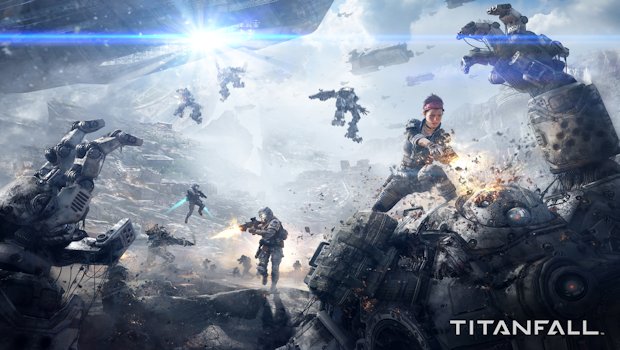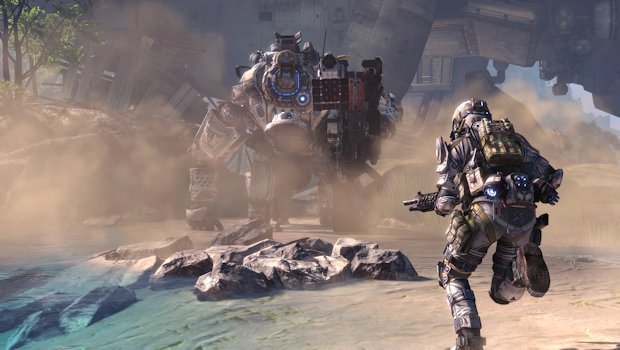I’m a veteran, over 75 drops and still going hard in the Frontier. And yet despite all my experience, I’m still excited every time I drop in to Angel City or the ruined town of Fracture. As I stand on the deck of the dropship preparing to repel another IMC incursion, I look to my squad mates and realize we have this. It doesn’t matter how well trained the IMC goons are, we are the best pilots in the Frontier and no one can stand up to the might of our titans working as a force. This is the next big thing in multiplayer shooters. This is Titanfall.
It is easy to scoff at claims that Titanfall, the first game from Respawn Entertainment, is the game that is going to change the way multiplayer first person shooters are designed. After all, every game that comes out has spin pushing it as the next big thing. Once one plays Titanfall though, all of those claims start to fall into place.
For those that want to put the game down, the derogatory phrase floating around internet forums is that Titanfall is Call of Duty with mechs. This causes fans of Titanfall to get all riled up and in turn ignites unreadable flame wars. It is stupid and unnecessary but like many things in the gaming community, it all seems par for the course.
While a bit dismissive of the many new things that Respawn brings to the table with the game, the reality is that Titanfall is in many ways Call of Duty with mechs. Respawn’s legacy is that of Call of Duty and no one should be surprised that Titanfall borrows many of the core aspects that helped propel that game to the massive success it has experienced. As someone who has played, and continues to play, a lot of Call of Duty, Titanfall’s initial impression is that the games feel similar.
Controlling my pilot for the first time, the game felt incredibly like Call of Duty. There is a fluidity to how Call of Duty controls and that is all present in Titanfall. Movement felt a bit accelerated but not amazingly so and the act of shooting was exactly what I expected. That said, Titanfall tacks on a few layers of depth to the gameplay, depth that once experienced makes the game feel completely fresh and new.
At the outset of a match, Titanfall drops you cinematically out of a dropship. You literally hit the ground running, a complete change of pace from other modern shooters and one that helps to immerse yourself into the narrative of the current battle. While cool, in terms of forming narrative cohesion for each battle, the effect isn’t exactly game changing in anyway. No, that happens once you start to play around with how the pilot handles.
After hitting the ground the immediate draw was to continue with that forward momentum to the nearest building. Initially I wanted to find an entrance and make my way to the top of the building by conventional means. Titanfall is built to allow you to do this if you so want but it is also designed to allow for a faster, more vertical approach. Titanfall gives its players a jump pack which enables them to basically double jump, making walking up stairs a thing of the past. It takes a bit of getting used to but once I got the hang of it, it felt perfectly natural.
The jump pack paired with the ability to wall run fundamentally changes the nature of movement in the game. It also changes the tactical approach players have to take as well. Camping is not a valid tactic here for the most part. If you are staying in one place, especially in the team deathmatch-like mode Attrition, then you are probably not helping your team and/or you are exposed to the point where you probably also going to die quickly. This is because of two things. The first is obviously the added agility that the game presents. Sitting on a rooftop or in a second story window isn’t anywhere as safe as it once was. Pilots can easily maneuver around the map making attack points from nearly every angle. Additionally, Titanfall has borrowed from MOBA’s like League of Legends and DOTA 2 by including fodder enemies. These enemies aren’t particularly dangerous but they also cannot be ignored, as such, constant movement is not just a suggestion, it is a requirement.
The fodder enemies, which flesh out the battlefield to feel more epic in scope while keeping players honest, also serve the purpose of fueling the epic Titan drops that the game is named after. Every round starts off with a titan timer for pilots. That timer can be shortened by killing enemies both human and AI. Once dropped players can jump into their titan, a massive mechanized suit of body armor that can rain destruction down on the opposing team. These titans though, while amazingly powerful, aren’t invincible. When piloting a titan I had to be aware of enemy titans as well as enemy pilots and AI specters, all of which can do some major damage to your destructive behemoth.
Every pilot is outfitted with anti-titan weaponry that can quickly deplete a titan’s health. But more fun than shooting rockets at titans from afar is getting up close and personal by “rodeoing” enemy titans and destroying them from on top. It’s an amazing feeling to be unloading into a titan from on top of it, depleting its energy to the point of a nuclear explosion and then jumping off to safety.
The great thing about the titans, though, is that everyone gets one. While the better players will get their titans first, the lesser skilled players will get their chance in the awesome hardware. This achieves a couple things, the first being that one never feels like they won’t experience the awesome parts of the game. The other being that it keeps the skilled players on their toes because no matter how weak those players might be, if they pair up with another titan on their team, they can be super destructive.
Aside from the maneuverability and mech gameplay though, Titanfall offers a couple other new takes on current shooter trends. Instead of perks, Titanfall has burn cards. These cards can be earned by completing challenges or doing certain things in a round of play and they offer players the opportunity to set themselves up for one life with a special perk, be it an active radar or a souped up weapon, but once that life is over the card is burned and no longer in play. It’s an interesting approach to the perk system while not allowing it to overwhelm the game with its implementation.
The final piece that seemingly spruces up current trends was Titanfall’s challenges. While not new in and of themselves, Titanfall’s challenges deliver a sense of progression in a game that I haven’t felt since the first Black Ops game. The challenges in the Alpha and Beta came fast and furious and I was always making progress in one way or the other and the way it shows you your six most current challenges makes you want to continue to play game after game because just one more match will unlock this challenge or that one. It’s a great sense of accomplishment that I don’t get from either Call of Duty: Ghosts or Battlefield 4.
But all of this can be attributed to Titanfall’s stellar gameplay. If it wasn’t so much fun to continue to jump in and battle some more I’d have stopped playing and moved on to something else. Instead I logged 15 hours into both the Alpha and Beta, maxing my level in both and continuing to play the same two maps over and over again. Each battle was different, each battle told its own story, and each battle was fun. Just like with Call of Duty: Modern Warfare, the guys at Respawn have seemingly done it again, finding the key to reinvigorating the modern shooter once more.
At the end of the day, despite my confidence, the IMC had won the battle and we were forced to evacuate Angel City. As I got to our evac point I watched another pilot get gunned down. I brought up my sights, avenged her death and hopped on board my ride out of here. Out of six pilots that went down to fight, we only brought back two but we’ll regroup and take the fight to the IMC another day. The cycle will repeat over and over again because this is Titanfall and it is looking to be something truly special.


